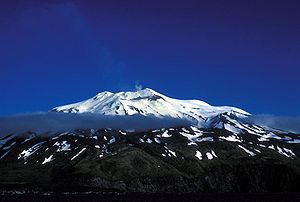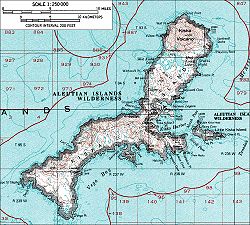Kiska Island
| Kiska | ||
|---|---|---|
| Mount Kiska | ||
| Waters | Pacific Ocean | |
| Archipelago | Aleutian Islands | |
| Geographical location | 51 ° 57 ' N , 177 ° 27' E | |
|
|
||
| length | 35 km | |
| width | 9.7 km | |
| surface | 103.3 km² | |
| Highest elevation |
Mount Kiska 1221 m |
|
| Residents | uninhabited | |
| Map of the West Aleutian Islands, Kiska in the east (7) | ||
Kiska ( aleutian : Qisxa ) is an island of Rat Islands within the island group of the Aleutian Islands in the US -Bundesstaat Alaska . The island is 35 km long and max. 9.7 km wide.
At the northern end of the island, Mount Kiska is a stratovolcano . It is 1221 m high and measures between 8.5 and 6.4 km in diameter. In an eruption of the volcano on 24 January 1962 was cinder cone on his flank, and lava came out. The volcano is regularly active; small amounts of lava, ash and steam keep coming out.
history
On his Great Nordic Expedition (1733-1743) Vitus Bering explored parts of the Aleutian Islands and in 1741 discovered Kiska. Georg Wilhelm Steller , a scientist who went on the Bering expedition, wrote in his diary on the occasion of the discovery:
On the 25th of October we had very clear weather with sunshine. Nevertheless it hailed several times in the afternoon. In the morning we were amazed to see a large high island at 51 degrees from us in the north, which we had on the outward journey forty miles from us in the east. At noon you were at 50 degrees 35 minutes north latitude.
From 1775 Kiska, like Alaska and the Aleutian Islands, became a trading post for the fur trade in North America , which was organized by the Russian Grigori Ivanovich Schelichow .
In 1867 Alaska was bought by the United States from the Russian Empire ( Alaska Purchase ). This also included Kiska.
Second World War
On June 6, 1942, 500 Japanese marines landed on the island. The aim of the operation was to distract from preparations for the Battle of Midway . The Japanese killed two members of a weather station and captured eight. The next day they occupied Attu Island .
At that time, the island was of little military importance. However, the psychological impact was great due to the first occupation of American territory by a sovereign state. In the winter of 1942/43 the Japanese increased the occupation troops to 2,000 men and built defenses and an airfield.
The Americans tried to get the island back into their possession. So the Japanese supply lines began to be interrupted ( naval battle of the Komandorski Islands ) and the island was bombed several times. Nevertheless, the Japanese increased the occupation forces to 4,500 men, on the one hand to prepare for the further conquest of the Aleutians and on the other hand to prevent the Americans from occupying the Kuril Islands .
On August 17, 1943, the island was taken by the Americans and Canadians without a fight as part of the Aleutian campaign . In the course of Operation Cottage , nearly 35,000 allies landed on the island. However, they found that the Japanese had already evacuated Kiska. Nevertheless, 103 soldiers died as a result of friendly fire , a sea mine explosion and Japanese booby traps .
With the evacuation of the island, the Japanese were finally expelled from American territory. Despite its strategically favorable location, the island only played a minor role in the further course of the war. The former Japanese base was designated a federal memorial in 2008 as part of the World War II Valor in the Pacific National Monument .
After 1945
In 1983 a memorial stone was erected on the island by the 87th Mountain Infantry Regiment . Its inscription reads:
To the men of Amphibious Task Force 9 who fell here August 1943 placed here August 1983 by 87th Mountain Infantry Regiment.
Today the island is a National Historic Landmark and is under government protection. It is also part of the Alaska Maritime National Wildlife Refuge and has the largest population of crested and dwarf whale . However, the island's seabird populations are at great risk from the spread of rats .
A major environmental problem on the island is the remains of the Second World War . Due to the slow corrosion processes caused by the climate, rusted cannons, shipwrecks and other military equipment can be found everywhere.
In 2007 the submarine USS Grunion (SS-216), believed to be lost, was found off the coast .
Individual evidence
- ^ Bergsland, K Aleut Dictionary Fairbanks: Alaska Native Language Center, 1994.
- ^ Georg W. Steller: Journey from Kamchatka to America with the Commandeur-Capitän Bering , Saint Petersburg 1793, published by PS Pallas ( online ), p. 89.
- ^ Rhonda Roy: The Battle for Kiska. Originally Published in "Esprit de Corp Magazine", Volume 9 Issue 4 and Volume 9 Issue 5. In: Canadian Heroes. canadianheroes.org, May 13, 2002, accessed September 22, 2015 .
- ↑ http://www.robsmith.org/184th-inf/




